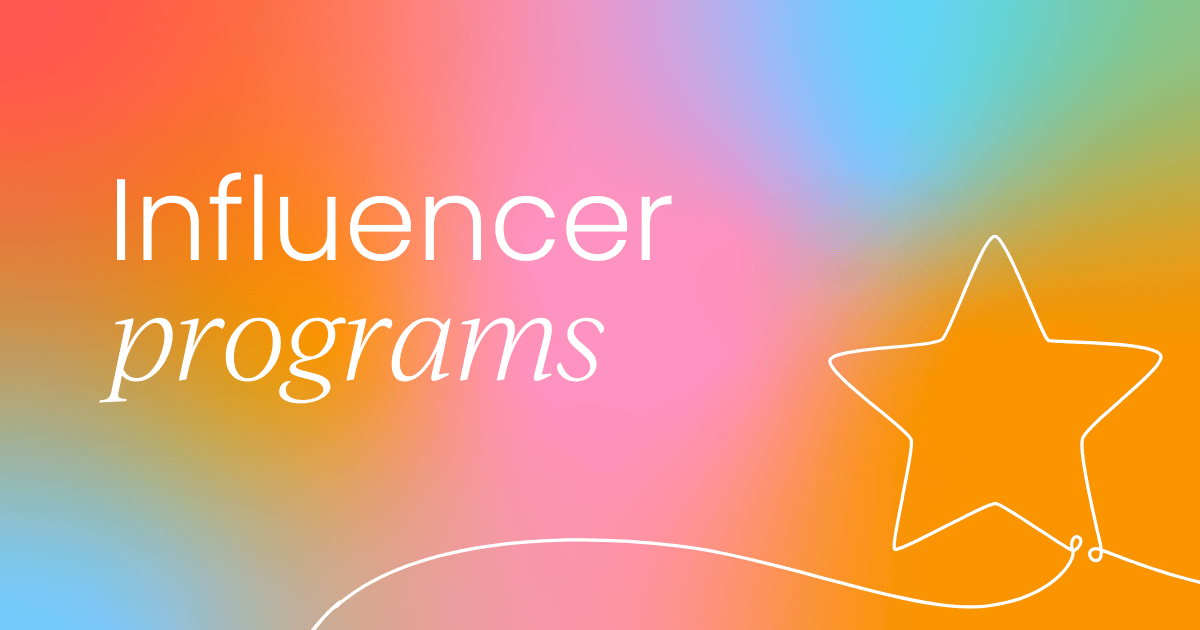Want to know how some brands turn influencer marketing into real results? You’ve come to the right place.
With the influencer marketing industry set to be worth a jaw-dropping $24 billion by the end of 2024, brands across the board are harnessing the power of influencers to get closer to their audiences.
And why wouldn’t they? After all, influencer marketing is now considered the third most effective marketing trend, right after short-form videos and content showing brand values (both of which play well in influencer campaigns), according to HubSpot’s 2024 State of Marketing Report.
In this article, we’ll dive into five standout influencer programs that have mastered the art of reaching audiences authentically and effectively. From brands that began with organic partnerships to those leveraging influencers for major events, each has a unique strategy that makes them worth watching.
Let’s dive in.
1. Gymshark
A quick search of #gymshark on Instagram reveals exactly what you’d expect: hundreds of images of fitness enthusiasts rocking their Gymshark gear.
From amateur gym-goers with 50K followers to professional power-lifters with millions, Gymshark has mastered influencer diversity. Some influencers are small and lean, while others look like they could flip a truck. But here’s what they all have in common: they fit the Gymshark brand.
Gymshark’s approach to influencer marketing started organically. Back in the day, when founder Ben Francis was still sewing each piece of apparel from his parents’ garage, he decided to send some gear to Lex Griffin, a fitness YouTuber he loved watching. This wasn’t a meticulously planned marketing move; it was simply a creator supporting a creator. And that authenticity? It resonated.
Fast-forward to today, and dozens if not hundreds of Gymshark influencers (affectionately dubbed “Athletes”) are showing their love for the brand, sharing products and discount codes in a way that feels real, not forced.
So, why does it work? Gymshark has built a genuine community. These Athletes are actual gym lovers sharing products they believe in, which makes the brand feel relatable and approachable, not like just another company trying to make a sale.
The results: Gymshark’s growth has been nothing short of meteoric. From a humble garage operation to a global fitness empire bringing in over $700 million a year, Gymshark is now a household name.
And Ben Francis? He’s gone from delivering pizzas to becoming Britain’s youngest self-made billionaire, proving that with the right community, you can achieve almost anything.
2. Semrush
Think influencer marketing is only for fashion or fitness brands? Semrush begs to differ. This B2B brand has taken influencer marketing by storm, proving that software can be just as "influencable" as the latest sneaker drop.
And they don’t hold back – Semrush combines a mix of practical tips, clever social insights, and a sprinkle of humor to reach audiences who may not have even known they needed Semrush until they saw it in action.
Some standouts? Short social videos featuring creators like Keira Jones and Joe Fenti. Keira, with her 100K TikTok followers, has helped drive Semrush’s message to young marketers in need of quick content strategy wins.
@thekeirajones How to boost TikTok views with content that's SEO optimized - using the Keyword Magic Tool from @Semrush! #AD #Semrushpartner ♬ original sound - Keira Jones | TikTok Coach
Meanwhile, Joe, a stand-up comedian with a knack for relatable content, has given his 304K Instagram followers a taste of Semrush’s value through laugh-out-loud skits that bring marketing struggles to life.
These creators made Semrush’s tools more accessible, helping them resonate with people who might otherwise have felt overwhelmed by SEO jargon.
Why it’s a win: Semrush nailed the balance between entertainment and education. Their creators didn’t just sell the tool; they showed how it could make their followers’ lives easier. Plus, their posts captured attention without feeling like a hard sell – a key strategy for standing out in a crowded social landscape.
The results: This influencer-powered strategy paid off big time. According to SocialPilot, Semrush not only boosted engagement on their own socials but saw an impressive uptick in new users and sign-ups. They reached millions, turning content viewers into product users – all by making digital marketing feel just a little more human.
3. Jack Wills
Clothing brand Jack Wills has always leaned into that distinctly British, Sloaney aesthetic – think posh, but with a laid-back preppy twist. And they’ve done a brilliant job of pairing that vibe with the perfect social media personalities.
Their approach? Take influencers who effortlessly embody the brand’s spirit and let them run with it. Whether they’re taking TikTok stars on ski trips or carefully curating Influencer Edits, Jack Wills has cracked the code on influencer campaigns that feel aspirational without crossing into “unreachable” territory.

Take their influencer trips, for example. In 2023, they whisked a mix of social media stars like Kate Elisabeth, Moyo, and Jack Joseph off to the Alps. Their followers got to see these personalities fully decked out in Jack Wills as they hit the slopes – from funny fails to picture-perfect moments.
The result? Millions of views, tons of likes, and a whole lot of Jack Wills visibility among Gen Z and millennial social media users.
And then there’s the Influencer Edits – capsule collections featuring influencer-selected pieces that ooze the Jack Wills vibe.
Take, for instance, the edit with Carms, a digital creator whose Instagram is a shrine to high fashion and luxury travel. Photographed in the well-heeled London borough of Chelsea, Carms models Jack Wills's apparel in a way that feels like an invitation to step into her world.
Her aesthetic meshes perfectly with the Jack Wills brand. It’s aspirational, sure, but also relatable – if you can’t be Carms on the Amalfi Coast, at least you can snag her gorgeous jacket.
Why it’s a win: Jack Wills nailed the art of matching influencers with their vibe. By choosing creators who align naturally with their brand, the content feels less like marketing and more like an authentic snapshot of the Jack Wills lifestyle. From the slopes to London’s swankiest streets, these influencers make Jack Wills gear look aspirational, though it’s relatively affordable.
The results: Thanks to these influencer collaborations, Jack Wills has locked down serious visibility among Gen Z – a generation that’s quick to scroll past anything too sales-y. By keeping it fun, relatable, and perfectly on-brand, Jack Wills managed to create influencer campaigns that resonate deeply, racking up millions of views across TikTok and Instagram.
4. Salesforce
When it comes to influencer marketing, Salesforce isn’t playing around – they’ve built a program that’s as layered as their CRM capabilities.
You might think B2B brands would struggle to create authentic influencer content, but Salesforce makes it look easy. By approaching their audience as humans first and keeping things flexible, they’ve created a network of advocates that spans employees, industry experts, and even big-name celebrities.
One of the pillars of Salesforce’s approach is its multi-tiered influencer network.
First, they have their employees and executives – the people who live and breathe the brand every day. Salesforce knows that audiences are more likely to trust “real” voices over branded messaging, so they encourage employees and executives to share updates, insights, and success stories.
This network also includes their Trailblazers community, where loyal users and community members act as advocates, showing how Salesforce solutions help real businesses thrive.
But they don’t stop there – Salesforce is savvy enough to know the power of micro-influencers. These smaller creators, with followers ranging from 10,000 to 100,000, bring authenticity and high engagement. And because they don’t command sky-high fees, they’re budget-friendly, making this element of Salesforce’s influencer program both impactful and cost-effective.
@corporate.bro What is AI you ask?? How about it’s the literal future. #AI #Comedy #dreamforce #workingintech ♬ original sound - Corp
Finally, let’s talk about their most memorable influencer campaign, “Dreamforce Goes Corporate.” To promote their flagship event, Dreamforce, Salesforce teamed up with comedy creators Corporate Bro and Corporate Natalie. Known for poking fun at the quirks of office culture, these influencers made Dreamforce feel fresh, fun, and surprisingly relatable for an industry conference.
Why it works: Salesforce isn’t afraid to mix employee advocacy with influencer partnerships and adjust campaigns based on audience and goals. This flexibility lets them tap into every corner of their audience, from industry veterans to Gen Z professionals.
Plus, by using micro-influencers, Salesforce showcases real user stories that don’t feel overly polished, making their brand more approachable and human.
The results: Salesforce’s influencer approach has led to higher engagement rates, increased brand awareness, and a more relatable brand image. Their “Dreamforce Goes Corporate” campaign racked up some major engagement and even won Hello Partner’s Best B2B Influencer Marketing Campaign award, proving that a B2B brand can have just as much influence – and fun – as any B2C giant.
5. MVMT
MVMT (pronounced “Movement”) is another brand that has nailed the art of micro-influencer marketing.
Founded as a crowdfunded watch brand in 2013, they quickly realized the power of getting their products in front of audiences who valued style and simplicity – without paying mega-influencer fees. Instead, MVMT focused on micro-influencers, who typically have smaller followings but much higher engagement rates.
What makes MVMT’s strategy so effective is that micro-influencers are often happy to post in exchange for free products, rather than demanding the hefty price tags that come with bigger names. Plus, micro-influencers tend to have more engaged audiences. Their followers see them as relatable and trustworthy, so when they endorse a brand, it feels genuine.
MVMT’s decision to focus on these smaller creators paid off in a big way – the brand built a loyal customer base through authentic connections, racking up over 100,000 affiliate code conversions and 39,000 pieces of influencer-generated content along the way.
Why it’s a win: By prioritizing micro-influencers, MVMT managed to build a high-impact, cost-effective influencer program. They tapped into an audience that genuinely connected with the brand, making their watches and accessories feel like a must-have.
The results: MVMT’s influencer strategy is a testament to the power of micro-influencers. This strategy not only fueled growth but also led to MVMT’s acquisition by Movado for a cool $300 million in 2018 – not bad for a brand that started with a crowdfunding campaign.
Conclusion
These five brands prove there’s no one-size-fits-all approach to influencer marketing. From Gymshark’s authentic community of fitness lovers to Salesforce’s layered, human-centered approach, each example shows that the key to success is building a strategy that genuinely connects with your audience.
Here’s what we can learn from these standout influencer programs:
👥 Know your audience: Whether you’re a fitness brand or a software provider, the most effective campaigns meet people where they are and give them something of value.
🧑💼 Think beyond the big names: Micro-influencers may not have millions of followers, but their high engagement and relatability can work wonders.
🤝 Focus on genuine connections: Whether through relatable content or community-building, influencers who genuinely love your brand are sure to show it in the best light.
😂 Have fun with it: Don’t underestimate the power of comedy. Relatable, comedic content cuts through the noise and makes your brand more memorable.
These examples serve as a reminder that influencer marketing isn’t just about reach; it’s about resonance. Build genuine relationships, stay adaptable, and remember: the best campaigns don’t just speak to your audience – they engage them.



 Follow us on LinkedIn
Follow us on LinkedIn



